人教版七年级英语下册unit3教案
- 格式:doc
- 大小:47.50 KB
- 文档页数:8
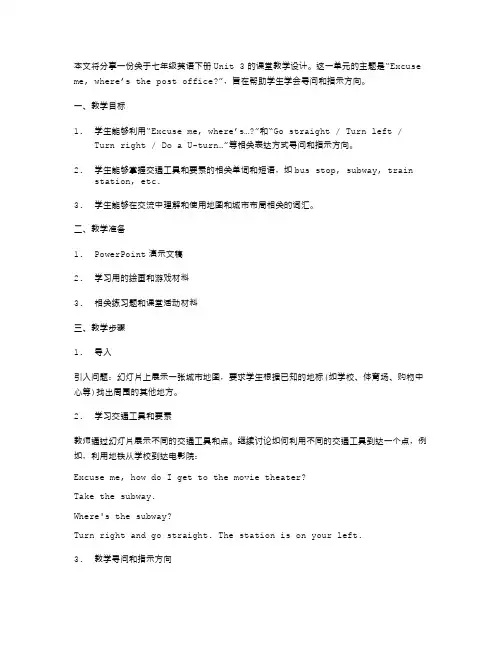
本文将分享一份关于七年级英语下册Unit 3的课堂教学设计。
这一单元的主题是“Excuse me, where’s the post office?”,旨在帮助学生学会寻问和指示方向。
一、教学目标1.学生能够利用“Excuse me, where’s…?”和“Go straight / Turn left /Turn right / Do a U-turn…”等相关表达方式寻问和指示方向。
2.学生能够掌握交通工具和要素的相关单词和短语,如bus stop, subway, trainstation, etc.3.学生能够在交流中理解和使用地图和城市布局相关的词汇。
二、教学准备1.PowerPoint演示文稿2.学习用的绘画和游戏材料3.相关练习题和课堂活动材料三、教学步骤1.导入引入问题:幻灯片上展示一张城市地图,要求学生根据已知的地标(如学校、体育场、购物中心等)找出周围的其他地方。
2.学习交通工具和要素教师通过幻灯片展示不同的交通工具和点。
继续讨论如何利用不同的交通工具到达一个点,例如,利用地铁从学校到达电影院:Excuse me, how do I get to the movie theater?Take the subway.Where's the subway?Turn right and go straight. The station is on your left.3.教学寻问和指示方向教师在幻灯片上展示不同地理位置的照片和地图,提示学生开始学习如何问路和指路。
教师向学生展示如何使用“Excuse me, where’s…?”句型,以及“Go straight / Turn left / Turn right / Do a U-turn…”等表达方式来指示方向。
教师可以与学生分组进行角色扮演,以加强他们的语言进程和提高他们的口语表达能力。
4.练习方向、地图和城市布局相关的词汇通过游戏、图片和绘画等多种形式收集和展示不同的地图和城市布局相关的单词和短语,例如:Bus stop / Subway / Train stationNorth / South / East / WestOn the left / On the right / Across the street / Next to5.面向现实场景的实践通过现实场景的练习加强学生的学习效果。
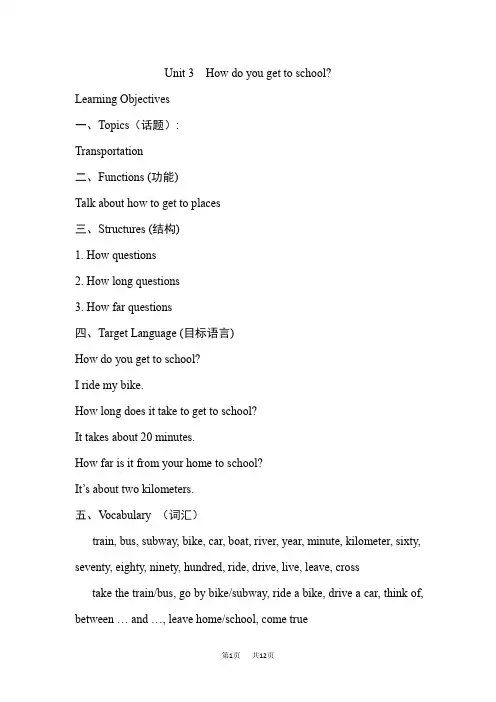
Unit 3 How do you get to school?Learning Objectives一、Topics(话题):Transportation二、Functions (功能)Talk about how to get to places三、Structures (结构)1. How questions2. How long questions3. How far questions四、Target Language (目标语言)How do you get to school?I ride my bike.How long does it take to get to school?It takes about 20 minutes.How far is it from your home to school?It’s about two kilometers.五、V ocabulary (词汇)train, bus, subway, bike, car, boat, river, year, minute, kilometer, sixty, seventy, eighty, ninety, hundred, ride, drive, live, leave, cross take the train/bus, go by bike/subway, ride a bike, drive a car, think of, between … and …, leave home/school, come true六、Skills (技能)Listening for key informationScanning in reading七、Recycling (复习巩固)Numbers 1–30I usually …It is easy to …Thanks for …八、教材分析本单元以How do you get to school?为中心话题,主要运用How long/How far 询问“去某地的交通方式、时间、距离”,简单描述路线。
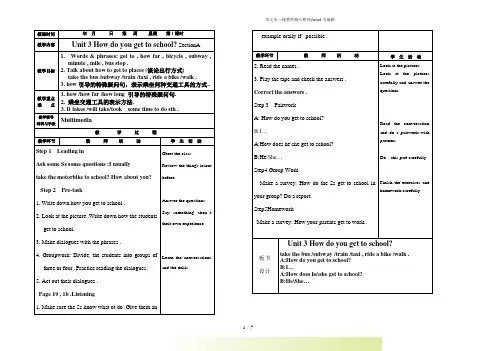
授课时间年月日第周星期第1课时教学内容Unit 3 How do you get to school? SectionA教学目标1. Words & phrases: get to , how far , bicycle , subway ,minute , mile , bus stop .2. Talk about how to get to places (谈论出行方式)take the bus /subway /train /taxi , ride a bike /walk .3. how引导的特殊疑问句,表示乘坐何种交通工具的方式..教学重点难点1. how /how far /how long 引导的特殊疑问句.2. 乘坐交通工具的表示方法.3. It takes /will take/took some time to do sth .教学辅导材料与手段Multimedia教学过程教学环节教师活动学生活动Step 1 Leading inAsk some Ss some questions :I usuallytake the motorbike to school? How about you? Step 2 Pre-task1. Write down how you get to school .2. Look at the picture .Write down how the studentsget to school.3. Make dialogues with the phrases .4. Groupwork: Divide the students into groups ofthree or four .Practice reading the dialogues. 5. Act out their dialogues .Page 19 , 1b .Listening1. Make sure the Ss know what ot do .Give them an Greet the classReview the things learntbefore.Answer the questions.Say something abou ttheir own experience.Learn the conversationsand the drills.example orally if possible .教学环节教师活动学生活动2. Read the names .3. Play the tape and check the answers .Correct the answers .Step 3 PairworkA: How do you get to school?B:I…A:How does he\she get to school?B:He\She…Step4 Group WorkMake a survey: How do the Ss get to school inyour group? Do a report.Step5HomeworkMake a survey: How your parents get to work..Look at the pictures.Look at the picturescarefully and answer thequestions.Read the conversationand do a pairwork withpartners.Do this part carefullyFinish the exercises andhomework carefully.板书设计Unit 3 How do you get to school?take the bus /subway /train /taxi , ride a bike /walk .A:How do you get to school?B:I…A:How does he\she get to school?B:He\She…教学反思授课时间年月日第周星期第2课时教学内容Unit 3 How do you get to school? SectionA 教学目标1.复习基数词及时间的表示方法.2.了解中外文化的差异.教学重点难点1.It takes /will take/took some time to do sth .2. Target language. The use of the drill.教学辅导材料与手段Multimedia教学过程教学环节教师活动学生活动Step 1 Leading in1. Greetings .2. Check the homework .Step 2 Pre –taskPage 20 , 2a.2b&2c .1. Revise the numbers .2. Teach the new word :minute .3. Play the tape for the students to finish Greet the classReview the things learntbefore.Revise the numbers .Listen to the recordingcarefully.2a&2c .Then play again and check theanswers ..4. Go over the dialogue in Page20 ,2d.Step 3 Pre-taskCheck the answer.教学环节教师活动学生活动Page 20 ,Grammar focus .1. Review the grammar box .Ask students to saythe statements and responses .2. Practice reading .Explain the usage of “take” in “take the train”and “take some time to do sth” .activityStep 4 PairworkMake a conversation about how you get toschool. Then practice in pairs.Step5 HomeworkRemember the Grammar Focus .Read the conversationand do a pairwork withpartners.Do this part carefullyFinish the exercises andhomework carefully.板书设计Unit 3 How do you get to school? Numbers: 32 40 41 50 60 70 80 90 100 Phrases:It takes /will take/took some time to do sth .教学反思授课时间年月日第周星期第3课时教学内容Unit 3 How do you get to school? SectionA教学目标1. 复习how far ,how long 引导的特殊疑问句.2. Reading practice.3. Writing practice.4.New words and phrases: town ill worry so much教学重点难点1. Key vocabulary, key phrases2. Target language. The use of the drill.教学辅导材料与手段Multimedia教学过程教学环节教师活动学生活动Step 1 Leading in1.Have Ss make sentences with “take to” .Explain the usage of “take” in “take the train”and “take some time to do sth” .Step 2 While-taskPage 21,3a .1. Pay attention to the speech bubbles .Read thequestions .2. Read the passage by the Ss. Find the answersto the questions and write the answers on thelines .Correct the answers .Step 3 Page 21, 3b .Greet the classReview the things learntbefore.Answer the questions.Say something abouttheir own experience.Learn the conversationsand the drills.教学环节教师活动学生活动1. Show Ss the example in the box .Two studentsread it to the class .2. Pairwork: Make your own conversations usingthe information in the left box.3. Ask some pairs to present the conversations tothe classStep 4 Post-taskPage 21 ,Part 4 .Groupwork.Divide the Ss into groups of three .In each group ,one is A,who look at Page 21.One is B,who look at Page 85,the other is C,who look at Page 86 .Fill in the blanks .The group who fill in the blanks first wins .Step 5 HomeworkWrite the sentences in Part 4 on the exercise books .Look at the pictures. Look at the pictures carefully and answer the questions.Read the conversation and do a pairwork with partners.Read this part carefullyFinish the exercises and homework carefully.板书设计Unit 3 How do you get to school?A:How far is it from your home to school?B:It’s…It takes/took sometime to do something.教学反思时间年月日第周星期第4课时教学内容Unit 3 How do you get to school?. SectionB教学目标1. vocabulary :bus stop bus station train station subwaystation .2. 能力目标:谈论上学的全过程。


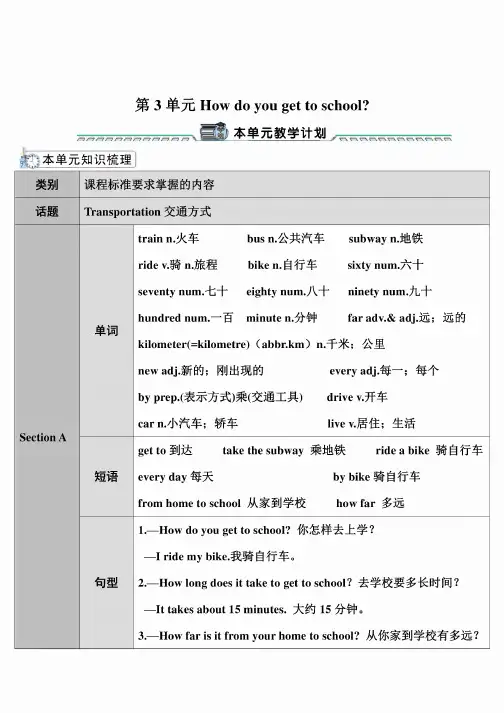
第3单元How do you get to school?本单兀教学计划弋,本单元知识梳理类别课程标准要求掌握的内容话题Transportation交通方式Section A 单词train n.火车bus n.公共汽车subway n.地铁ride v.骑n.旅程bike n.自行车sixty num.六十seventy num.七十eighty num.八十ninety num.九十hundred num.一百minute n.分钟far adv.&adj.远;远的kilometer(-kilometre)(abbr.km)n.千米;公里new adj.新的;刚出现的every adj.每一;每个by prep.(表小方式)乘(交通工具)drive v.开车earn.小汽车;轿车live v.居住;生活短语get to到达take the subway乘地铁ride a bike骑自行车every day每天by bike骑自行车from home to school从家到学校how far多远句型1.—How do you get to school?你怎样去上学?一I ride my bike.我骑自行车。
2.一How long does it take to get to school?去学校要多长时间?—It takes about15minutes.大约15分钟。
3.—How far is it from your home to school?从你家到学校有多远?一Ifs only about two kilometers.大约只有2千米。
4.H ave a good day at school.祝你在校过得愉快。
5.D oes Jane walk to school?简步行去学校吗?Section B 单词stop n.车站;停止cross v.横过;越过river n.河;江many adj.&pron.许多villagen.村庄;村镇between prep.介于....之间bridge n.桥boat n.小船year n.年;岁afraid adj.害怕;畏惧like prep.像;怎么样villager n.村民leave v.离开;留下dream n.梦想;睡梦v.做梦true adj.真的;符合事实的ropeway n.索道短语think of认为;想起between...and...在....和....之间come true实现;成为现实have to不得不;必须句型1.Mary wants to know what he thinks of the trip.玛丽想知道他认为这次旅行怎么样。
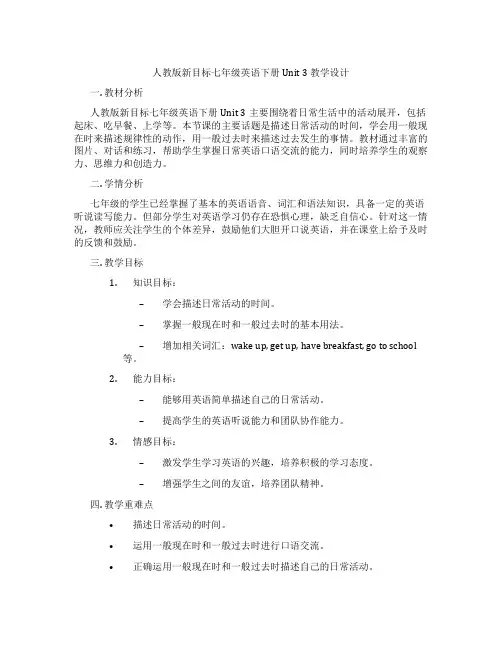
人教版新目标七年级英语下册 Unit 3 教学设计一. 教材分析人教版新目标七年级英语下册Unit 3主要围绕着日常生活中的活动展开,包括起床、吃早餐、上学等。
本节课的主要话题是描述日常活动的时间,学会用一般现在时来描述规律性的动作,用一般过去时来描述过去发生的事情。
教材通过丰富的图片、对话和练习,帮助学生掌握日常英语口语交流的能力,同时培养学生的观察力、思维力和创造力。
二. 学情分析七年级的学生已经掌握了基本的英语语音、词汇和语法知识,具备一定的英语听说读写能力。
但部分学生对英语学习仍存在恐惧心理,缺乏自信心。
针对这一情况,教师应关注学生的个体差异,鼓励他们大胆开口说英语,并在课堂上给予及时的反馈和鼓励。
三. 教学目标1.知识目标:–学会描述日常活动的时间。
–掌握一般现在时和一般过去时的基本用法。
–增加相关词汇:wake up, get up, have breakfast, go to school 等。
2.能力目标:–能够用英语简单描述自己的日常活动。
–提高学生的英语听说能力和团队协作能力。
3.情感目标:–激发学生学习英语的兴趣,培养积极的学习态度。
–增强学生之间的友谊,培养团队精神。
四. 教学重难点•描述日常活动的时间。
•运用一般现在时和一般过去时进行口语交流。
•正确运用一般现在时和一般过去时描述自己的日常活动。
•学会在适当的情境下使用一般现在时和一般过去时。
五. 教学方法1.情境教学法:通过设定生活情境,让学生在实际语境中学习、运用英语。
2.任务型教学法:引导学生参与各种小组活动,提高学生的团队协作能力和口语表达能力。
3.激励评价法:及时给予学生反馈,关注学生的点滴进步,激发学生的学习兴趣。
六. 教学准备1.教学素材:教材、多媒体课件、录音机、磁带、相关图片等。
2.教学工具:黑板、粉笔、投影仪等。
七. 教学过程1.导入(5分钟)–教师与学生用英语进行自由谈话,引导学生谈论日常活动。
–提问:What time do you get up? What do you have for breakfast? 让学生用英语回答。
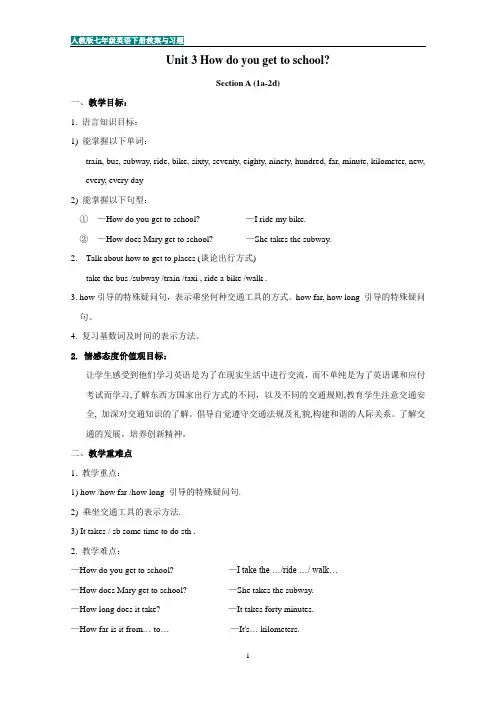
Unit 3 How do you get to school?Section A (1a-2d)一、教学目标:1. 语言知识目标:1) 能掌握以下单词:train, bus, subway, ride, bike, sixty, seventy, eighty, ninety, hundred, far, minute, kilometer, new, every, every day2) 能掌握以下句型:①—How do you get to school? —I ride my bike.②—How does Mary get to school? —She takes the subway.2. Talk about how to get to places (谈论出行方式)take the bus /subway /train /taxi , ride a bike /walk .3. how引导的特殊疑问句,表示乘坐何种交通工具的方式。
how far, how long 引导的特殊疑问句。
4. 复习基数词及时间的表示方法。
2. 情感态度价值观目标:让学生感受到他们学习英语是为了在现实生活中进行交流,而不单纯是为了英语课和应付考试而学习,了解东西方国家出行方式的不同,以及不同的交通规则,教育学生注意交通安全, 加深对交通知识的了解。
倡导自觉遵守交通法规及礼貌,构建和谐的人际关系。
了解交通的发展,培养创新精神。
二、教学重难点1. 教学重点:1) how /how far /how long 引导的特殊疑问句.2) 乘坐交通工具的表示方法.3) It takes / sb some time to do sth .2. 教学难点:—How do you get to school? —I take the …/ride …/ walk…—How does Mary get to school? —She takes the subway.—How long does it take? —It takes forty minutes.—How far is it from… to…—It's… kilometers.三、教学过程Ⅰ. Warming-up and Lead in学生和老师进行简单的问候Ss : Good morning , teacher.T: Good morning , classT: Look at the picture. What can you see? Do you like your school? I usually get to school by bike, but sometimes on foot . How do you get to school?Ss 按实际情况作答S1: I ride my bike.S2: I go by bus.S3: ………T: Very good. You’re clever. Let’s learn Unit 4 Section A.之后板书:“Unit 4 How do you get to school?”Ⅱ. Presentation1. T: If you are here, but your school is in Shanghai. How do you get to school?Ss: I take the bus /plane/ boat / ship / car / taxiI ride a bike / motorbikeT: Do you know any other way?2. Teacher shows pictures on the big screen .归纳出行方式和常用短语.Ask some questions about how you get to…?(让学生积极主动的思考想象总结,多媒体增加趣味性,加强直观性,效果事半功倍)3. Show a picture about Part 1, on the screen.Point at girls or boys in the picture.Ask students to answer and write in the blanks.S1 : How does he / she go to school?S2 : He / She … …Ⅲ. 1aT: Look at the picture on your book. Match the words with the picture.(学生们完成1a的学习任务,然后校对答案)Ⅳ. Listening1. Make sure the Ss know what to do. Give them an example orally if possible.2. Read the names in the box.3. Play the tape and check the answers.Ⅴ. Pair workAsk two students to read the dialogue in the speech bubbles to the class. Then ask students to work in pairs. Ask and answer how students get to school in the picture.Finally ask some pairs of students to present their conversations to the class.Ⅵ. Listening1. Revise the numbers, first, zero~nine, next, ten~nineteen, then, twenty, thirty, forty…finally,twenty-one, twenty-two…Teach the new word "hundred".2. Play the tape for the students to finish 2a. Then play again and check the answersⅦ. PresentationShow a picture on the TV and explain these are your home and school.Teach: home----school How long 10 minutes How far two kilometersThen make up a dialogue to practice.A: How do you get to school?B: I usually take the bus.A: How far is it from your home to school?B: It's about two kilometers.A: How long does it take?B: It takes 30 minutes by busⅧ. Listening1. Tell Ss the following recording is about how Tom and Jane go to school.2. First, listen to the recording fill in the first column.3. Then, play the recording for the Ss again. Ss listen and complete the rest of the chart.4. Check the answers.Ⅸ. Role-play1. Read the dialogue and find the answer to these questions:①How does Jane get to school?②How far is it from home to school?③How long does it take to get to school from her home?2. Ss read the conversations and then find the answers to the questions.3. Check the answers with the class.4. Play the recording for the Ss to listen and repeat.5. Ss read the conversation then role-play the conversation.6. Let some pairs act out the conversation.Homework1. Remember the new words and expressions in this period.2. Role-play the conversation after class.Section A (Grammar Focus-3c)一、教学目标:1. 语言知识目标:1) 继续练习谈论出行方式take the bus /subway /train /taxi, ride a bike /walk .2)用不同方式练习how引导的特殊疑问句,表示乘坐何种交通工具的方式。

Unit 3 How do you get to schoolPeriod 1教学内容与分析教学内容:Make a list ; Listen and write ; Pairkwork教学目标:1) 能够谈论:How do you get to school? 掌握各种交通工具的英语表达法。
2) 能够听、说、认读句子:A:How does Bob get to school? B:He takes the train.3) 能用熟练地运用这些句型对不同交通工具的使用进行谈论和比较。
教学重点、难点分析教学重点:能够听、说、读、写各类交通工具并在实际情景中会运用How do you get to school?句型进行交际活动。
教学难点:take ride the/ a …to + 地点= go to + 地点+ by…walk to +地点= go to + on foot教学设计Teaching proceduresStep ⅠWarming-up and Revision1.Greetings and free talk.2.RevisionStep ⅡLead in1. Listen and guess what it is.Listen and guess what it is. Revise the old words and teach the new words.2. Guessing gameThe teacher say a sentence ask the students to guess what kind of transportation it is.---It is like a bike but goes much faster. ---A motorbike.---It is like a train but goes under the ground. ---A subway.---It goes in the water. ---A ship or a boat.---It takes you about three hours to go to Beijing from Shenzhen by it. ---A plane.---It can take people to the moon. ---A spaceship.---It is very useful, you may ride it to school. ---A bike3. There are so many transportations around the world. What kind of transportation do you like to choose ?Ask how do you get to school/Shanghai/ Hangzhou/ Luqiao /Paris….?Help the students answer:I take the subway./take the bustake a minibus /take a taxitake the train / take the planetake the ship/take the carride my/a bikeride a motorbike/walkStep ⅢTo work in pairs, ask and answerAsk the students to work in pairs.A: How do you get to school?B: I walk to school. I ride a bike to school.I take a bus to school. I take a car to school.I take the subway to school. I take the train to school.Step ⅣPresentation1. First ask two students to ask and answer in pair.Then ask the other students “how does he/she get to school?”He/She takes the subway. /……rides his/her bike……walks.Step ⅤGroup workAsk the students to do group work.A: How do you get to school?B: I take the bus. / ride my bike/ bicycle./ walk.C: How does he /she get to school?He/She takes the bus/… rides his/her bike/bicyc le ./ walks.Step ⅥWork on 1a and 1b.1. To do Section A 1a look at the picture and write down the way of transportation.2. To listen to the tape and finish1b.Step ⅦPresentationAsk “h ow does Bob get to school?’ Help them answer he takes the train.Then ask “how does Paul get to school?” "He walks."Say Paul usually walks to school. He goes to school on foot.Show some pictures to students. Ask them to say like this.My father rides a bike to work every day. =My father goes to work by bike every day. Step ⅧTo work in pairs, ask and answerShow some pictures to the students then ask then to work in pairs.A: How do you get to......? B: I take/ride/walk......I get to school...by.../on...Step ⅨSummaryTake/ride the/a ...to+地点=go to +地点+by....Walk to+地点=go to +on foote.g. He often takes the subway to work.=He often goes to work by subway.注意:当home, here, there 作地点时to 不要。
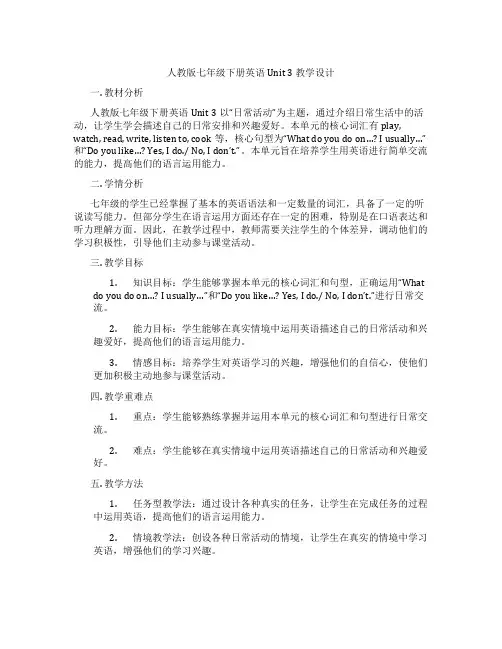
人教版七年级下册英语Unit 3 教学设计一. 教材分析人教版七年级下册英语Unit 3以“日常活动”为主题,通过介绍日常生活中的活动,让学生学会描述自己的日常安排和兴趣爱好。
本单元的核心词汇有play, watch, read, write, listen to, cook等,核心句型为“What do you do on…? I usually…”和“Do you like…? Yes, I do./ No, I don’t.”。
本单元旨在培养学生用英语进行简单交流的能力,提高他们的语言运用能力。
二. 学情分析七年级的学生已经掌握了基本的英语语法和一定数量的词汇,具备了一定的听说读写能力。
但部分学生在语言运用方面还存在一定的困难,特别是在口语表达和听力理解方面。
因此,在教学过程中,教师需要关注学生的个体差异,调动他们的学习积极性,引导他们主动参与课堂活动。
三. 教学目标1.知识目标:学生能够掌握本单元的核心词汇和句型,正确运用“Whatdo you do on…? I usually…”和“Do you like…? Yes, I do./ No, I don’t.”进行日常交流。
2.能力目标:学生能够在真实情境中运用英语描述自己的日常活动和兴趣爱好,提高他们的语言运用能力。
3.情感目标:培养学生对英语学习的兴趣,增强他们的自信心,使他们更加积极主动地参与课堂活动。
四. 教学重难点1.重点:学生能够熟练掌握并运用本单元的核心词汇和句型进行日常交流。
2.难点:学生能够在真实情境中运用英语描述自己的日常活动和兴趣爱好。
五. 教学方法1.任务型教学法:通过设计各种真实的任务,让学生在完成任务的过程中运用英语,提高他们的语言运用能力。
2.情境教学法:创设各种日常活动的情境,让学生在真实的情境中学习英语,增强他们的学习兴趣。
3.小组合作学习:学生进行小组讨论和合作,培养他们的团队精神和沟通能力。
六. 教学准备1.教材:人教版七年级下册英语教材。
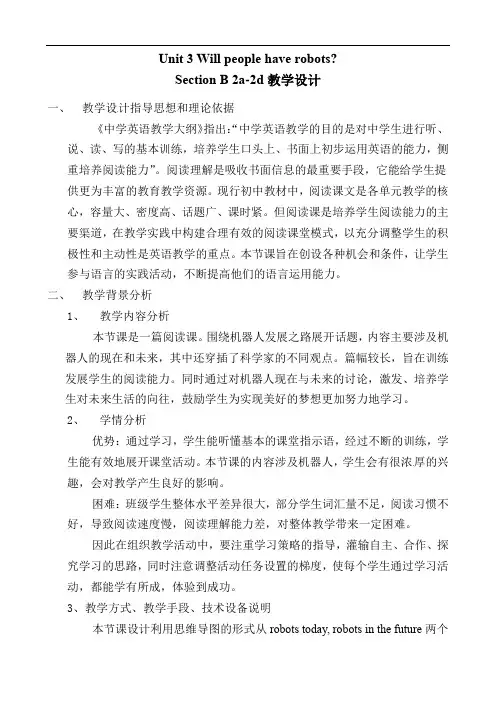
Unit 3 Will people have robots?Section B 2a-2d教学设计一、教学设计指导思想和理论依据《中学英语教学大纲》指出:“中学英语教学的目的是对中学生进行听、说、读、写的基本训练,培养学生口头上、书面上初步运用英语的能力,侧重培养阅读能力”。
阅读理解是吸收书面信息的最重要手段,它能给学生提供更为丰富的教育教学资源。
现行初中教材中,阅读课文是各单元教学的核心,容量大、密度高、话题广、课时紧。
但阅读课是培养学生阅读能力的主要渠道,在教学实践中构建合理有效的阅读课堂模式,以充分调整学生的积极性和主动性是英语教学的重点。
本节课旨在创设各种机会和条件,让学生参与语言的实践活动,不断提高他们的语言运用能力。
二、教学背景分析1、教学内容分析本节课是一篇阅读课。
围绕机器人发展之路展开话题,内容主要涉及机器人的现在和未来,其中还穿插了科学家的不同观点。
篇幅较长,旨在训练发展学生的阅读能力。
同时通过对机器人现在与未来的讨论,激发、培养学生对未来生活的向往,鼓励学生为实现美好的梦想更加努力地学习。
2、学情分析优势:通过学习,学生能听懂基本的课堂指示语,经过不断的训练,学生能有效地展开课堂活动。
本节课的内容涉及机器人,学生会有很浓厚的兴趣,会对教学产生良好的影响。
困难:班级学生整体水平差异很大,部分学生词汇量不足,阅读习惯不好,导致阅读速度慢,阅读理解能力差,对整体教学带来一定困难。
因此在组织教学活动中,要注重学习策略的指导,灌输自主、合作、探究学习的思路,同时注意调整活动任务设置的梯度,使每个学生通过学习活动,都能学有所成,体验到成功。
3、教学方式、教学手段、技术设备说明本节课设计利用思维导图的形式从robots today, robots in the future两个方面梳理文章脉络,并指导学生用思维导图来复述文章,锻炼学生的归纳总结和语言表达能力。
运用“讨论-限时自读-导读-复读-讨论”的基本课堂教学模式,设计学生学习活动。
七年级下册Unit 3 How do you get to school ?写作教学案(教师使用)【话题】交通(Transportation)【写作目标】要求学生能能够熟练表达或者询问怎样去某地。
【课前任务】一、写出下列短语。
1、客车上落站2、火车站3、地铁站4、步行5、坐地铁6、村庄7、桥 8、多远参考答案:1.bus stop 2.train station 3.subway station 4.on foot 5.take the subway 6.village 7. bridge 8. how far二、根据汉语意思完成下列句子。
1、我花费一小时坐火车到那里It ____________ ____________ an hour ____________ get there .2、我坐船去上班。
I get to work ____________ ____________.3、学校和村庄之间有一条河。
There is a very big river ____________ their school ____________ the village.4、还要过多久你就到达北京?____________ ____________ will you____________ ____________ Beijing?5、从学校到医院有多远?____________ ____________ is it ____________ the school ____________ the hospital?参考答案:1. takes me , to 2.by boat 3. between , and 4.How soon , arrive in/get to 5.How far , from , to三、写出与本话题有关的词汇和句型。
常用词汇:take the train,take the bus,ride a bike,walk经典句型:How do you get to school?It takes 20 minutes.How long does it take to get to school? It takes about15 minutes.How far is it from your home to school? It's only about two kilometers.【课中任务】读写结合一、A. 信息归纳阅读下面短文,然后按照项目要求填写所缺信息。
Unit 3How do you get to school?单元目标第一课时Section A (1a-2e) 课时目标3.How far is it from your home to school? 从你家到学校有多远?4.I'm not sure...about 10 kilometers?我不确定……大约10公里?5.How long does it take you to get to school? 你到学校要用多长时间?教学难点教会学生使用不同的方法表达交通方式;掌握本课时的重点短语和句型及其用法;初步了解how的相关用法自主学习根据句意及音标提示写出单词及其汉语意思。
1.We will go to Beijing by train /treɪn/. 火车2.My mother goes to work by subway /'sʌbweɪ/. 地铁3.She can ride /raɪd/ a motorcycle. 骑4.He walked two hundred /'hʌndrəd/ and sixty /'sɪkstɪ/ miles in thirty days. 一百;六十5.A nice little Italian restaurant is not far /faː(r)/ from here. 远;远的6.I want to buy a new /njuː/ pen. 新的7.I take the bus to go to school every /'evrɪ/ day. 每一;每个教学过程环节1新课导入T:Hello, everyone!How many kinds of transportation do you know? Can you call their names?Ss:Taxi, subway, bike, train, plane, bus...T:OK, good. Look at the pictures and answer the questions.T:These pictures are about the transportation that you have mentioned. I usually get to school by bike, but sometimes on foot.Can you tell me how you get to school?S1:I ride my bike.S2:By bus.T:OK! Today we will learn more about transportation.Ss:That sounds great!设计意图:教师通过展示交通工具的图片吸引学生的注意力,以师生之间对话的方式自然地过渡到本课时的话题上来,同时也调动了学生参与课堂的积极性。
第四课时Section B(2a—3b)教学目标通过本课的学习,学生能够:1.获取和梳理本课语篇的信息和涉及的what、how、why句型的关键信息;理解并掌握本课时重点词汇,如cross、river、village、bridge、between…and…等。
(获取信息)2.使用速读、寻读和思维导图的阅读策略对语篇信息进行结构性梳理,并在语境中正确理解和区分词性。
(梳理整合)3.深层思考亮亮上学方式变化的原因,并清楚阐述自己的观点,提高自身思维品质。
(内化应用)4.借助小组活动,合作探究的方式,懂得珍惜自己的生活和学习条件,从而更努力地学习。
(迁移创新)语篇研读What:本语篇介绍了一个偏远乡村孩子亮亮上学的故事,亮亮出生于偏远山区,上学方式艰辛,但他毫无畏惧,热爱校园,热爱老师,热爱学业。
Why:这一题材展现了偏远地区孩子上学的艰苦,目的是为了唤起城市孩子的关注,同时让他们懂得珍惜自己的生活和学习条件,从而更努力地学习。
How:2a在培养学生的预测能力,2b侧重于语篇信息理解,2c活动则利用句子填空的方式来强化、巩固对阅读内容的理解。
教学过程设计理念:以《英语课程标准》核心素养为导向,以单元主题为引领,基于语篇的育人理念,体现《英语课程标准》“学思用创”的英语学习活动观和“教—学—评”一体化设计理念。
教学目标学生活动效果评价Lead-in通过呈现课文标题及图片,引导学生预测文章的大体内容,并利用读前阶段对文段标题及图片的讨论,渗透一部分生词,从而减轻阅读时的生词压力,做好阅读铺垫1.Greeting.2.Show the title and the picture of thepassage.Let students guess what thestory is about.Who are they?They’re going to school on aropeway.Do you think it’s easy forthem?New words:cross the river,bridge,ropeway,dangerous,afraid.教师鼓励学生对课文内容进行大胆预测,根据学生的表现预判学生的能力并了解学生的兴趣,根据学生的回答情况给予帮助和鼓励设计意图通过预测导入本文段主体,并让学生预测文段大致内容,引起他们的思考,激发他们的思维。
第三单元第二课时 Section A(Grammar Focus ~ 3c)§自主学习方案学生自学新单词(教材P15的单词),看谁记得又快又准。
(2分钟)【新词自查】根据首字母或汉语提示完成句子。
1.I usually go to school by bus.2.Miss Li,our English teacher,lives five miles from our school.3.My parents often drive to work(开车上班)every day.4.He rides his bike(骑自行车)to the bus station.5.It takes me about half an hour to walk to school(步行去学校).§课堂导学方案Step 1谈话式导入Teacher:How do you get to school?Students:I usually…Teacher:How long does it take you to get from your home to school?Students:It takes…Teacher:How far is it from your home to school?Students:It’s around…(同时,可以根据学生的回答用第三人称向其他同学进行提问,这样可以锻炼学生口头表达能力和提高学生的听力水平。
)环节说明:通过自由谈话式的提问导入本单元的重点句型和语法基础知识,既复习了上节课的内容,又结合本单元的语法重点知识对学生进行口语和听力训练。
Step 2熟读Grammar Focu s1.让学生分男、女两组朗读Grammar Focus中的内容。
(2分钟)2.让同学们背诵Grammar Focus中的内容。
(2分钟)3.小结训练。
(2分钟)补全对话:在对话空白处填入一个适当的句子,使对话完整、正确。
Unit 3 How do you get to school?Section A (1a-2d)一、教学目标:1. 语言知识目标:1) 能掌握以下单词:train, bus, subway, ride, bike, sixty, seventy, eighty, ninety, hundred, far, minute, kilometer, new, every, every day2) 能掌握以下句型:①—How do you get to school? —I ride my bike.②—How does Mary get to school? —She takes the subway.2. Talk about how to get to places (谈论出行方式)take the bus /subway /train /taxi , ride a bike /walk .3. how引导的特殊疑问句,表示乘坐何种交通工具的方式。
how far,how long 引导的特殊疑问句。
4. 复习基数词及时间的表示方法。
二、教学重难点1. 教学重点:1) how /how far /how long 引导的特殊疑问句.2) 乘坐交通工具的表示方法.3) It takes / sb some time to do sth .2. 教学难点:—How do you get to school? —I take the …/ride …/ walk…—How does Mary get to school? —She takes the subway.—How long does it take?—It takes forty minutes.—How far is it from… to…—It's… kilometers.三、教学过程Ⅰ. Warming-up and Lead in学生和老师进行简单的问候Ss : Good morning , teacher.T: Good morning , classT: Look at the picture. What can you see? Do you like your school? I usually get to school by bike,but sometimes on foot . How do you get to school?Ss 按实际情况作答S1: I ride my bike.S2: I go by bus.S3: ………T: Very good. You’re clever. Let’s learn Unit 4 Section A.之后板书:“Unit 4 How do you get to school?”Ⅱ. Presentation1. T: If you are here,but your school is in Shanghai. How do you get to school?Ss: I take the bus /plane/ boat / ship / car / taxiI ride a bike / motorbikeT: Do you know any other way?2. Teacher shows pictures on the big screen.归纳出行方式和常用短语.Ask some questions about how you get to…?(让学生积极主动的思考想象总结,多媒体增加趣味性,加强直观性,效果事半功倍)3. Show a picture about Part 1, on the screen.Point at girls or boys in the picture.Ask students to answer and write in the blanks.S1 : How does he / she go to school?S2 : He / She … …Ⅲ. 1aT: Look at the picture on your book. Match the words with the picture.(学生们完成1a的学习任务,然后校对答案)Ⅳ. Listening1. Make sure the Ss know what to do.Give them an example orally if possible.2. Read the names in the box.3. Play the tape and check the answers.Ⅴ. Pair workAsk two students to read the dialogue in the speech bubbles to the class.Then ask students to work in pairs. Ask and answer how students get to school in the picture.Finally ask some pairs ofstudents to present their conversations to the class.Ⅵ. Listening1. Revise the numbers, first, zero~nine, next, ten~nineteen, then, twenty, thirty,forty…finally, twenty-one, twenty-two…Teach the new word "hundred".2. Play the tape for the students to finish 2a.Then play again and check the answersⅦ. PresentationShow a picture on the TV and explain these are your home and school.Teach: home----schoolHow long 10 minutes How far two kilometersThen make up a dialogue to practice.A: How do you get to school?B: I usually take the bus.A: How far is it from your home to school?B: It's about two kilometers.A: How long does it take?B: It takes 30 minutes by busⅧ. Listening1. Tell Ss the following recording is about how Tom and Jane go to school.2. First, listen to the recording fill in the first column.3. Then, play the recording for the Ss again. Ss listen and complete the rest of thechart.4. Check the answers.Ⅸ. Role-play1. Read the dialogue and find the answer to these questions:①How does Jane get to school?②How far is it from home to school?③How long does it take to get to school from her home?2. Ss read the conversations and then find the answers to the questions.3. Check the answers with the class.4. Play the recording for the Ss to listen and repeat.5. Ss read the conversation then role-play the conversation.6. Let some pairs act out the conversation.HomeworkRole-play the conversation after class.教学反思:学生们初步掌握take的用法但不熟练,需加强练习和记忆。
板书设计:一、1.1)23二、1. 教学重点:1) how /how far /how long 引导的特殊疑问句.2) 乘坐交通工具的表示方法.3) It takes sb some time to do sth .2. 教学难点:—How do you get to school? —I take the …/ride …/ walk…—How does Mary get to school? —She takes the subway.—How long does it take?—It takes forty minutes.—How far is it from… to…—It's… kilometers.三、教学过程Ⅰ. Warming- up and revision1. Greet the Ss as usual. Then check the homework.2. Go over the conversation in 2e.Ⅱ. Grammar Focus.1. 学生阅读Grammar Focus中的句子,然后做填空练习。
①你如何到达学校?_______________________我骑自行车。
____________________②她如何到达学校?___________________她乘公共汽车。
____________________③到达学校要花多长时间?____________________大约花费15分钟。
___________________④从你有到学校有多远?____________________仅约两公里。
____________________⑤简步行去上学吗?_______________________不,她骑自行车。
____________________⑥他们乘公共汽车去上学吗?_________________不,他们步行。